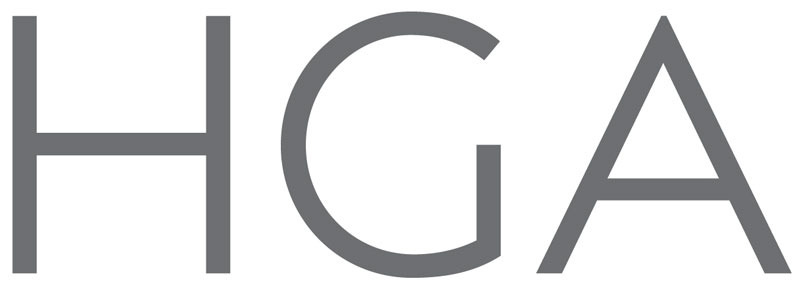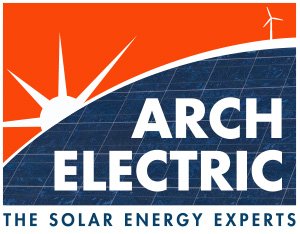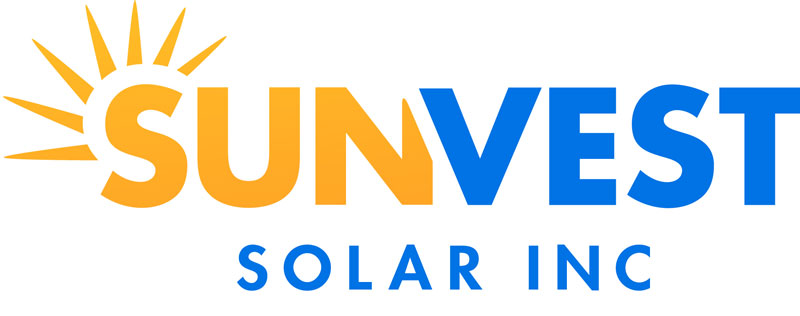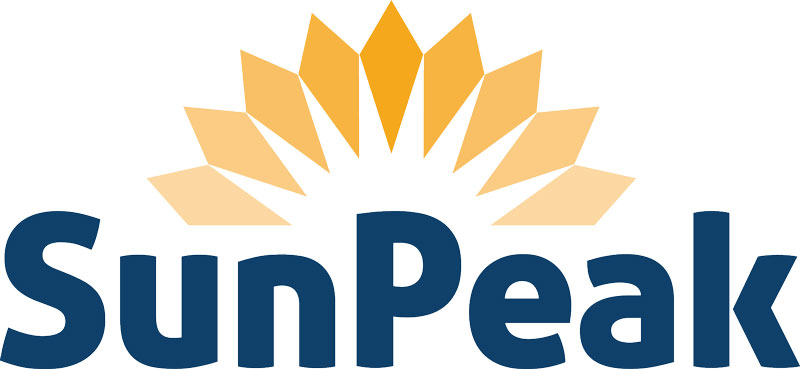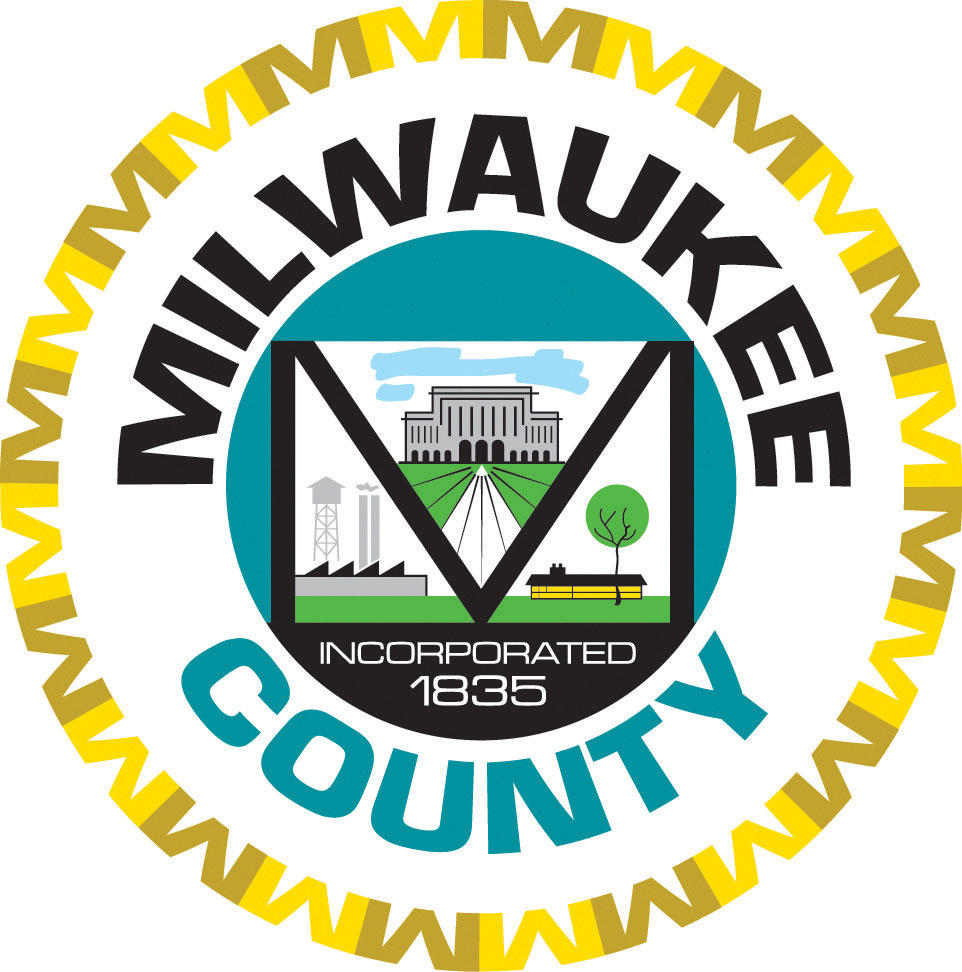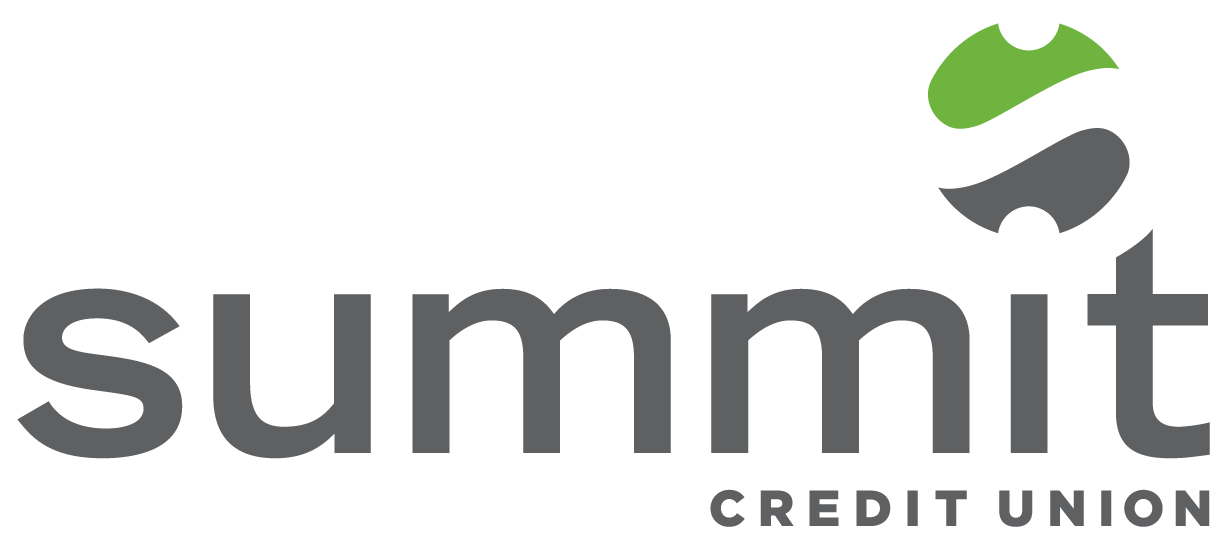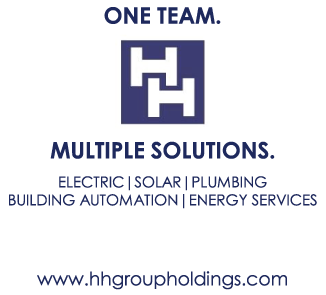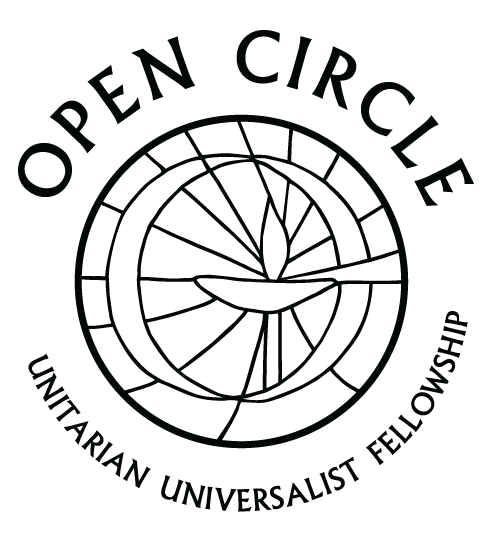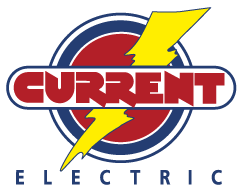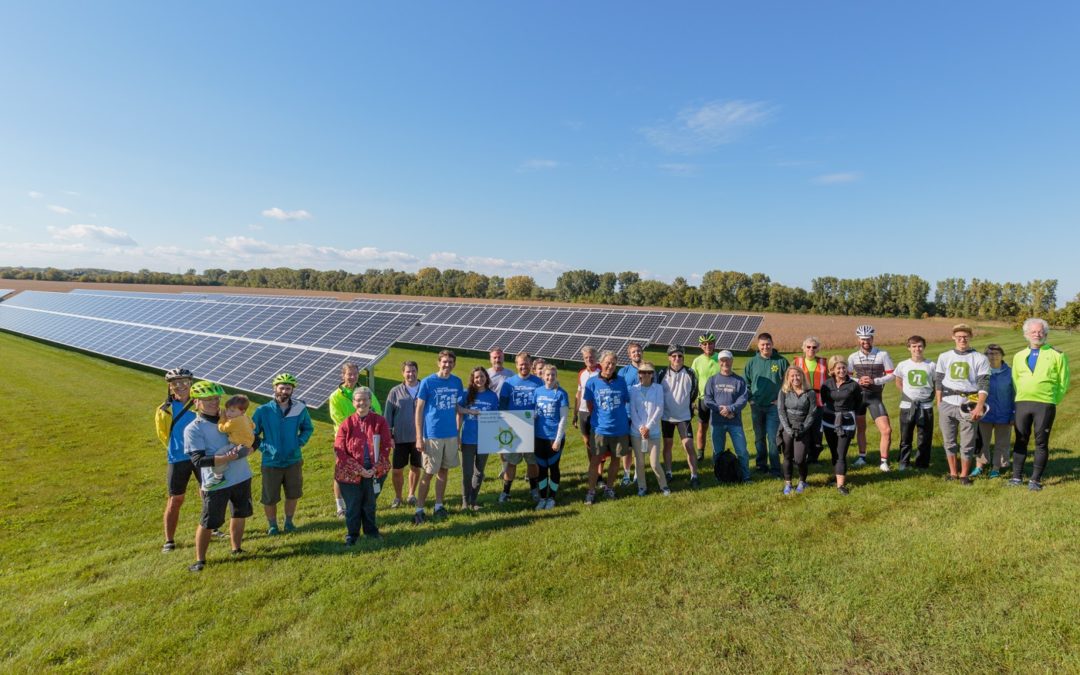
by Michael Vickerman | Oct 16, 2018 | Advocacy, Biogas, Focus on Energy, Programs, RENEW Wisconsin, Renewables, Solar, Wind
For many years, Focus on Energy’s renewable energy incentive program has labored under an operating environment resembling a regulatory roller-coaster. It has weathered funding suspensions, mid-stream budget reallocations, and an effort to replace rebates with loans.
But that extended wild ride is finally coming to an end, the result of Public Service Commission orders that will restore stability and consistency to Focus’s renewable energy offerings.
The PSC’s ruling in June 2018 locked in $22 million in renewable energy incentives for the 2019-2022 funding cycle, split equitably between residential and business customers. That allocation amounts to a funding increase of $4.7 million, or 27%, over the previous four-year cycle. In addition, the order granted flexibility to move funds between residential and business customers to better ensure all the funding is utilized.
A subsequent order in September 2018 locked in improvements to the business program, including a streamlined application process, a guarantee of request-for-proposals issued three times per year, and a funding set-aside for mid-size projects (between 20 and 100 kilowatts for solar power projects).
We are starting to see the results of these positive decisions!
The business program has an RFP on the street with applications due next week, on Tuesday, October 23rd, for the first round of projects that will be installed in 2019.
All in all, the PSC’s decisions tracked closely with the recommendations submitted by RENEW and its member businesses regarding funding levels and program design.
But before we dive into how it happened, RENEW wishes to thank PSC Chairperson Lon Roberts and Commissioners Mike Huebsch and Rich Zipperer for their votes in support of a strong, predictable, and consistent renewable energy program for Focus on Energy!
We would also like to thank the Commissioners’ Executive Assistants and the Commission’s Focus on Energy staff team for the role they each played in setting up success for 2019 through 2022.
The Anatomy of the Victory
Our goals for the 2018 planning process were twofold: first, to lock in a stable and well-funded operating environment for renewables; and second, to integrate needed process improvements to the incentive program targeting commercial installations. Our member businesses assisted us in formulating these recommendations which were based on an assessment of recently adopted tax and trade policies and their likely effects on customer appetite for onsite renewable generation.
Our success was made possible by the participation of several influential constituencies that weighed into the formal planning docket. For the first time in Focus on Energy’s history, associations representing general contractors, builders, and architects voiced their support for a well-funded renewable energy program. Drawing upon his background representing contractors at the Capitol, Jim Boullion, RENEW’s Government Affairs Director, was instrumental in engaging these groups to submit a letter conveying their support for continuing current funding levels over the next four years.
In addition, renewable energy businesses and associations across solar, biogas, and geothermal technologies weighed in with support. These businesses span the entire state, which helped us make the point that the renewable energy program serves rural and urban areas.

Geographic Representation of Signatories
Our success in 2018 was also made possible by RENEW’s organized media outreach and recognition swings across Wisconsin from 2015 through 2017. Those events highlighted the increasing appeal of rooftop solar for commercial customers, school districts, and agricultural producers, and called attention to the Focus on Energy incentives that moved these installations to completion.
The ribbon-cuttings and award ceremonies in locations such as Racine, New Berlin, and Darlington proved effective in generating positive coverage from the press. RENEW complemented that effort with analysis documenting the renewable program’s statewide reach and effectiveness in supporting Wisconsin businesses, both at the customer and contractor level.
That effort first bore fruit in October 2016, when the PSC decided to scrap the sputtering loan program and replenish the incentive budget for 2017 and 2018 with unspent loan dollars totaling more than $8.5 million. With that commitment in place, renewable energy businesses could bank on a relatively stable and adequate funding base, and break free of the fits and starts that had hampered their ability to meet growing customer demand.
Getting the 2017 and 2018 programs in place and, through our members, showing them to be successful gave us a strong negotiating position to showcase “what is working” and to advocate for continued rebate funding for 2019-2022.
In the end, it was a combination of RENEW’s strong advocacy on behalf of our member businesses and allies, and the PSC’s desire to see the program succeed that led to this positive outcome. We are fortunate to have so many actively engaged members who understand the value of speaking up with a unified voice.
Said RENEW Executive Director Tyler Huebner: “The Commissioners definitely heard the collective comments of our industry and stakeholders to make the renewable energy program as streamlined and business-friendly as possible. RENEW Wisconsin will continue to work with the Commission, PSC staff, and the Focus on Energy program administrators to make the programs simple for customers and the renewable energy marketplace, while ensuring cost-effective outcomes.”
Once again, thank you to our Members and Stakeholders who supported our positions, and to the PSC Commissioners, Executive Assistants, and Staff who all played instrumental roles in this process.
We look forward to a strong Focus on Energy renewable energy program for 2019 through 2022!
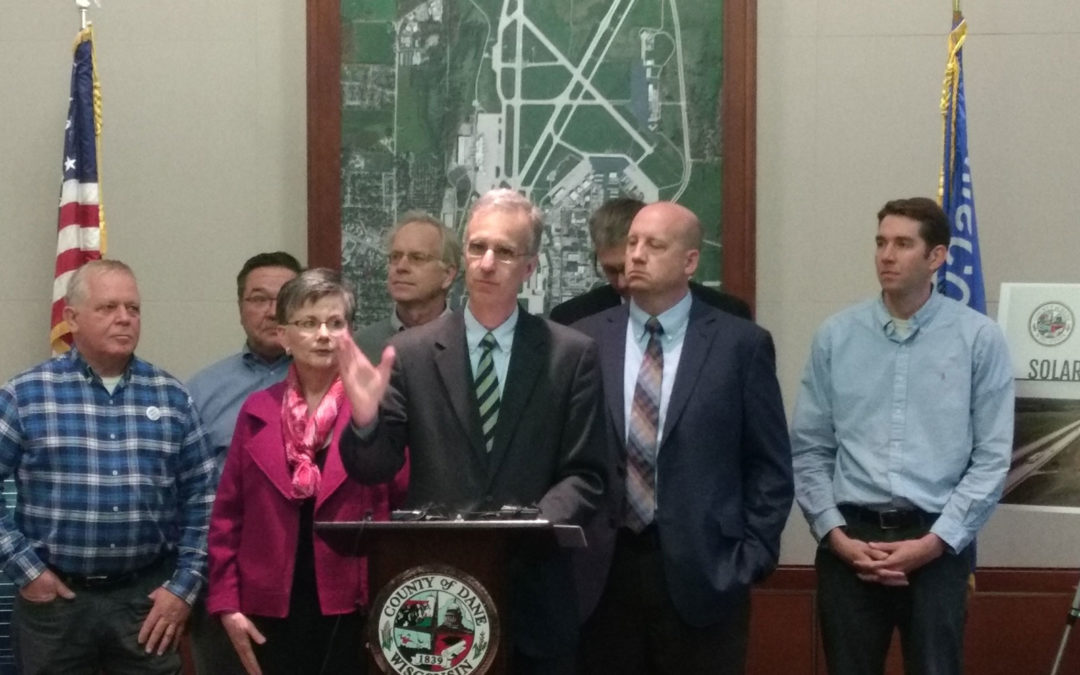
by Michael Vickerman | Oct 11, 2018 | Solar, Utilities
Dane County and Madison Gas and Electric (MGE) are joining forces to construct a solar power plant on County-owned land that will supply clean electricity for one customer only: Dane County. The solar array, expected to total eight megawatts of capacity, will be situated on a 41-acre parcel at the north end of Dane County Regional Airport. MGE will own the array, which will be interconnected directly to the utility’s distribution system nearby.
This project invites superlatives. When completed, it will be the largest solar power plant in Dane County, more than three times as large as Epic Systems’ 2.2 MW installation serving its Verona headquarters, and four times as large as Madison College’s 1.8 MW rooftop array at its Truax campus, which is expected to start generating electricity in November.
Thanks to its Renewable Energy Rider service, MGE has the capability of supplying commercial customers to clean electricity generated from new, offsite solar installations. Through this service, customers like Dane County can lock in a dedicated source of solar at a fixed price for up to 20 years. The cost of building a Renewable Energy Rider project would be borne exclusively by the customer or customers purchasing the electricity. Other nonparticipating customers would be unaffected by the transaction.
In this case, MGE will recover the full cost of building the airport installation from Dane County’s energy purchases. The county has a goal to source 100% of the electricity it consumes from renewable resources. The output from the airport project should total about 25% of the County’s annual electrical usage.
Later this fall, MGE will select a general contractor to design and build this installation. The utility will also file an application for permission to supply Dane County with the project’s output. The Public Service Commission will review the terms of the agreement to ensure that the airport array is cost-neutral from the standpoint of the utility’s other customers.
Dane County and MGE jointly unveiled its partnership at an October 1st press conference at the airport. The announcement also coincided with the unveiling of the County Executive’s proposed budget for 2019, containing a number of provisions to advance the County’s development and use of renewable energy. One of them involves Lake Farm Park, home of Lussier Family Heritage Center and numerous campsites. The proposed budget allocates $435,000 to build enough solar capacity to supply 100% of the electricity and hot water used at the park.
“Dane County is a nationally-recognized leader in renewable energy adoption and innovation. From the hardest-working landfill in the state, to what will be one of the largest solar farms in the state, I’m proud of the progress we’ve made,” said Dane County Executive Joe Parisi. “This historic solar farm will help increase local clean energy jobs, reduce carbon emissions, and reduce the tax burden on Dane County residents through lower energy bills.”
“MGE welcomes the opportunity to partner at the County’s request on this solar project and supports its efforts to achieve 100% renewable energy for its facilities,” said MGE Chairman, President and CEO Jeff Keebler.
If approved, construction of the project is expected to begin in 2019. For more information on the project see: https://www.countyofdane.com/press/details.aspx?id=4370

by Tyler Huebner | Oct 2, 2018 | Biogas, Events, RENEW Wisconsin, Solar, Solar for Good, Wind
On Saturday, September 29th, fifty bike riders enjoyed our sixth annual “Ride with RENEW” bicycle tour! This year’s tour was in Milwaukee and we saw solar, wind, and biogas renewable technologies up close.
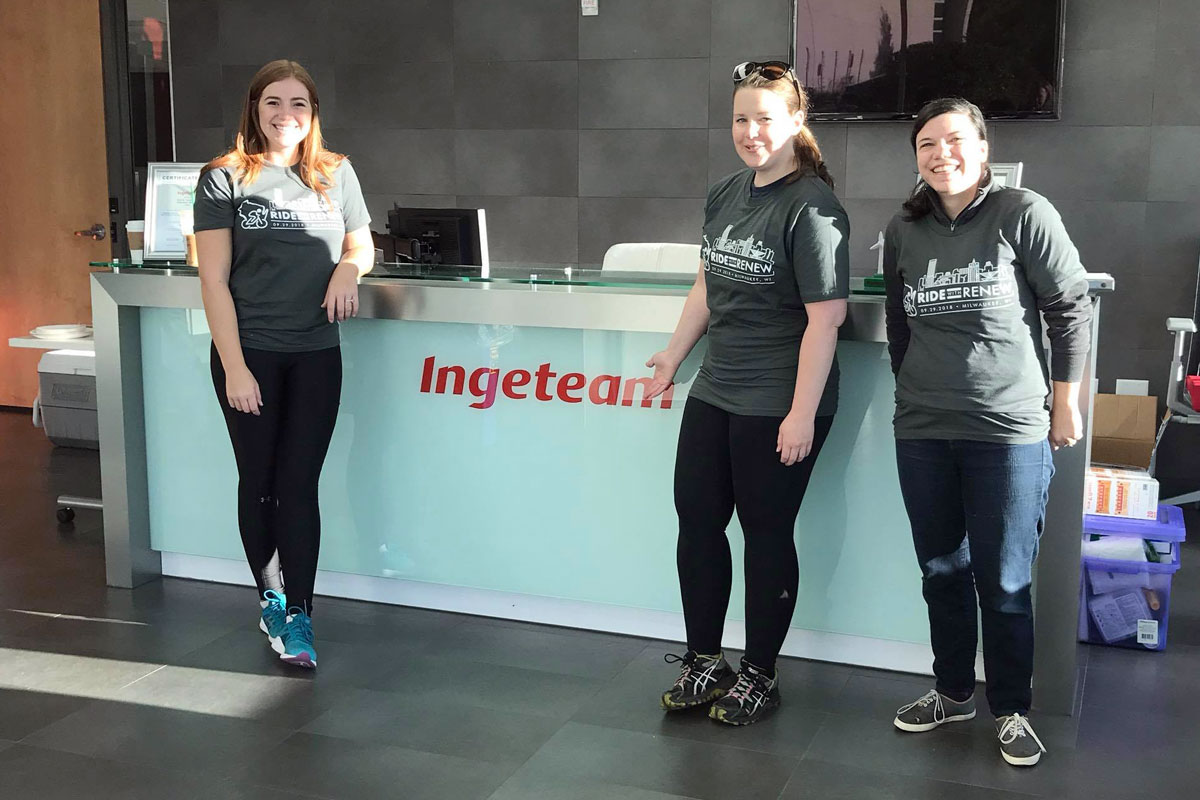 The day started off cool, but as the sun rose the temps came along with it. Ingeteam hosted our morning breakfast and registration, and we learned about their factory and US headquarters which builds wind generators and supports solar and wind projects nationwide.
The day started off cool, but as the sun rose the temps came along with it. Ingeteam hosted our morning breakfast and registration, and we learned about their factory and US headquarters which builds wind generators and supports solar and wind projects nationwide.
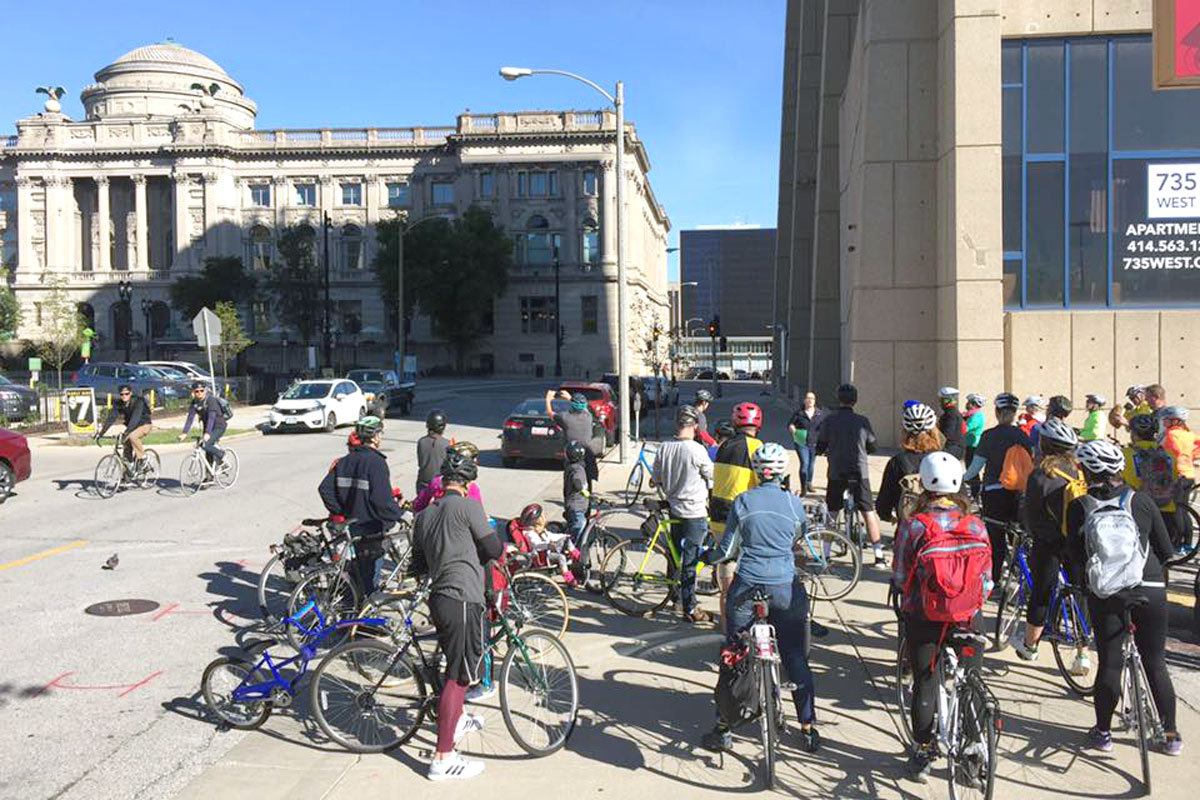 Next we visited the City of Milwaukee’s Public Library, where the City’s Elizabeth Hittman regaled our crowd with the City’s plans to install 1.1 megawatt of solar across six City buildings. The Library will get a 121 kilowatt solar PV system as part of this project.
Next we visited the City of Milwaukee’s Public Library, where the City’s Elizabeth Hittman regaled our crowd with the City’s plans to install 1.1 megawatt of solar across six City buildings. The Library will get a 121 kilowatt solar PV system as part of this project.
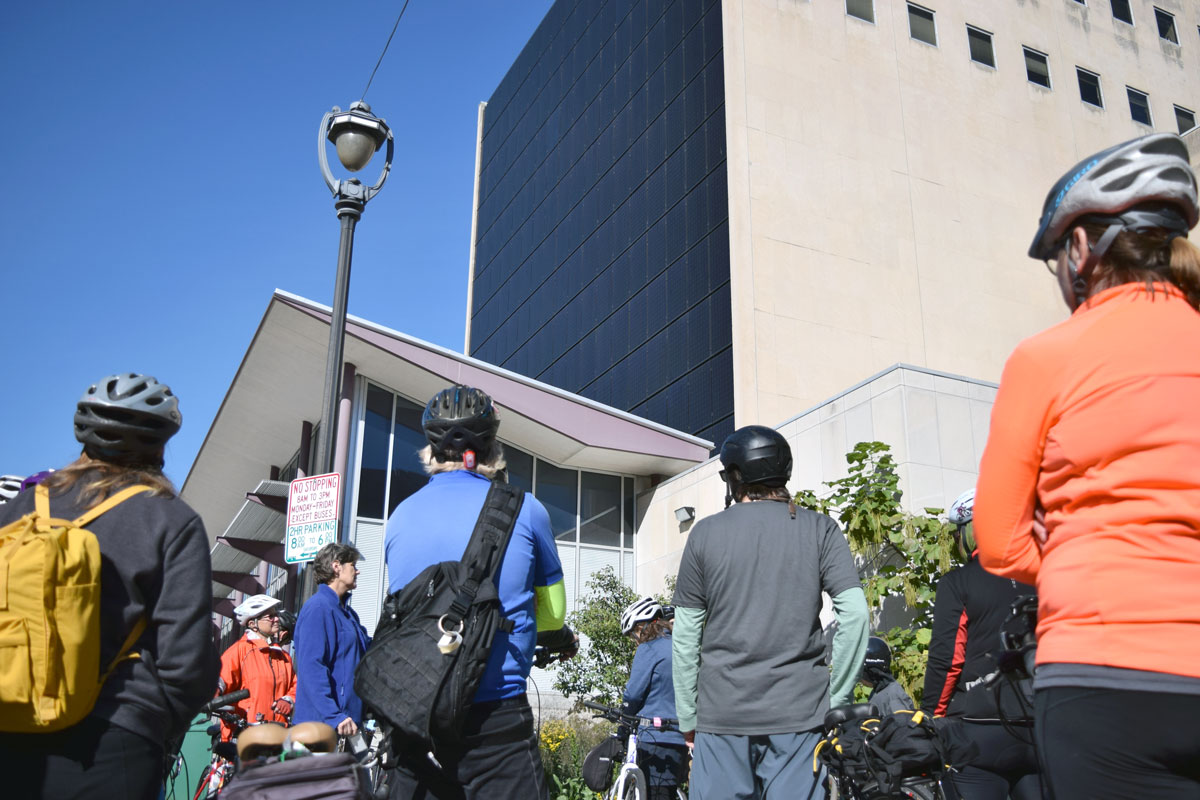 A block away, we visited the largest vertical solar PV wall in the U.S. according to project developer Convergence Energy. The project is at the Milwaukee Public Museum, and Director Ellen Censky motivated our crowd with her story of getting sustainability done!
A block away, we visited the largest vertical solar PV wall in the U.S. according to project developer Convergence Energy. The project is at the Milwaukee Public Museum, and Director Ellen Censky motivated our crowd with her story of getting sustainability done!
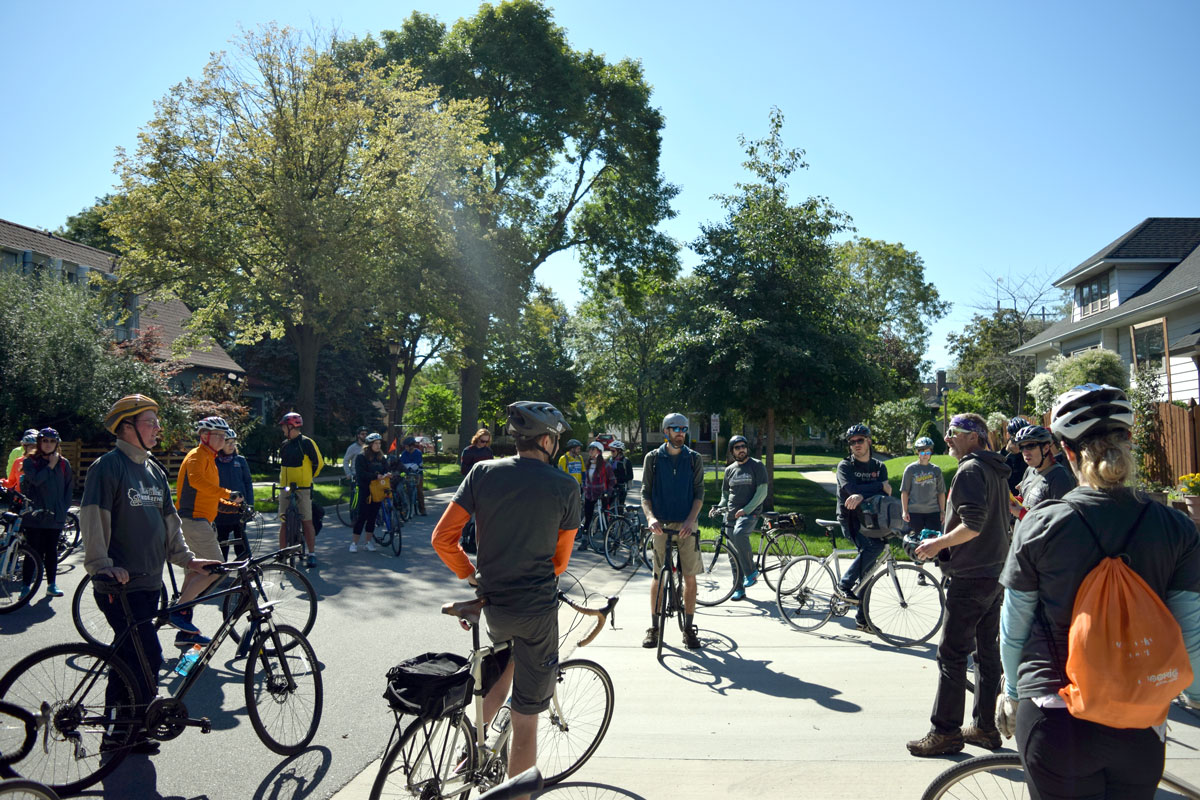 Next, we rode trails north to Shorewood where we saw solar on homes from a recent solar group buy through the City’s Milwaukee Shines Programand the Midwest Renewable Energy Association.
Next, we rode trails north to Shorewood where we saw solar on homes from a recent solar group buy through the City’s Milwaukee Shines Programand the Midwest Renewable Energy Association.
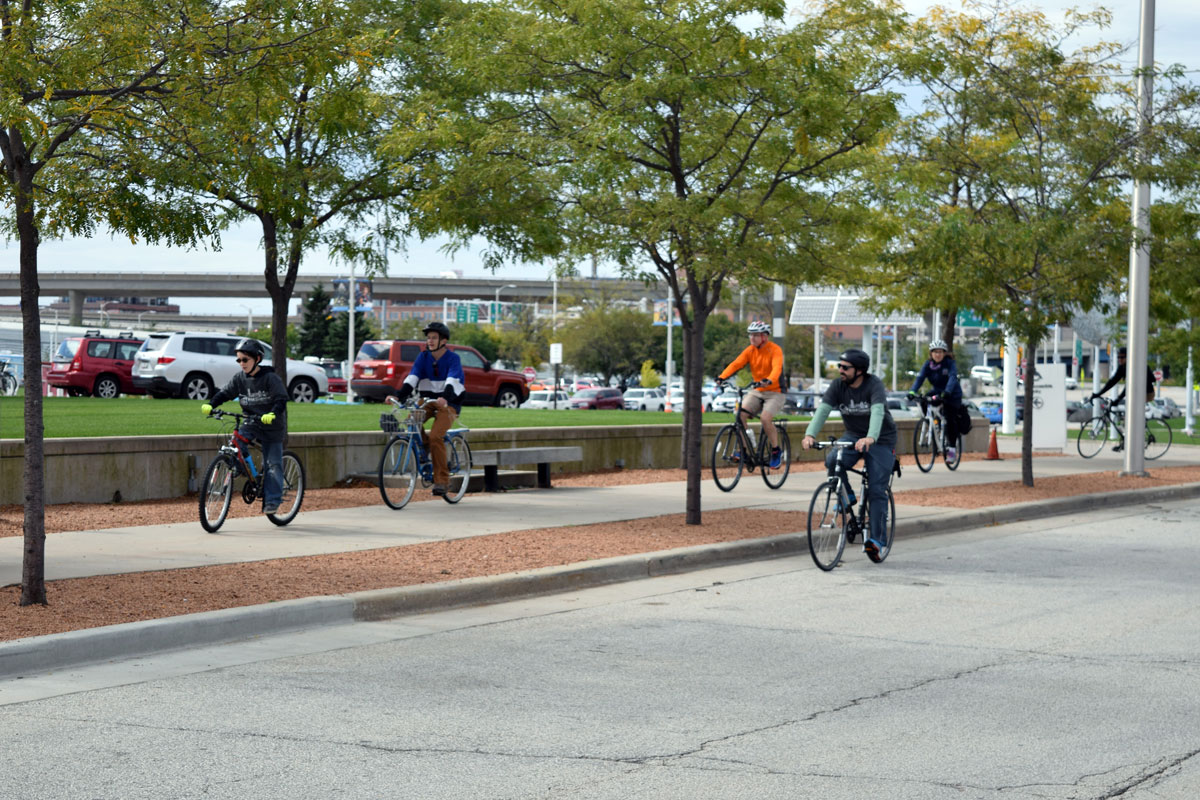 Then we headed to the lake, where we ate lunch at the Discovery World which includes geothermal heating and cooling, which ride sponsor HGA Architects helped integrate into the building.
Then we headed to the lake, where we ate lunch at the Discovery World which includes geothermal heating and cooling, which ride sponsor HGA Architects helped integrate into the building.
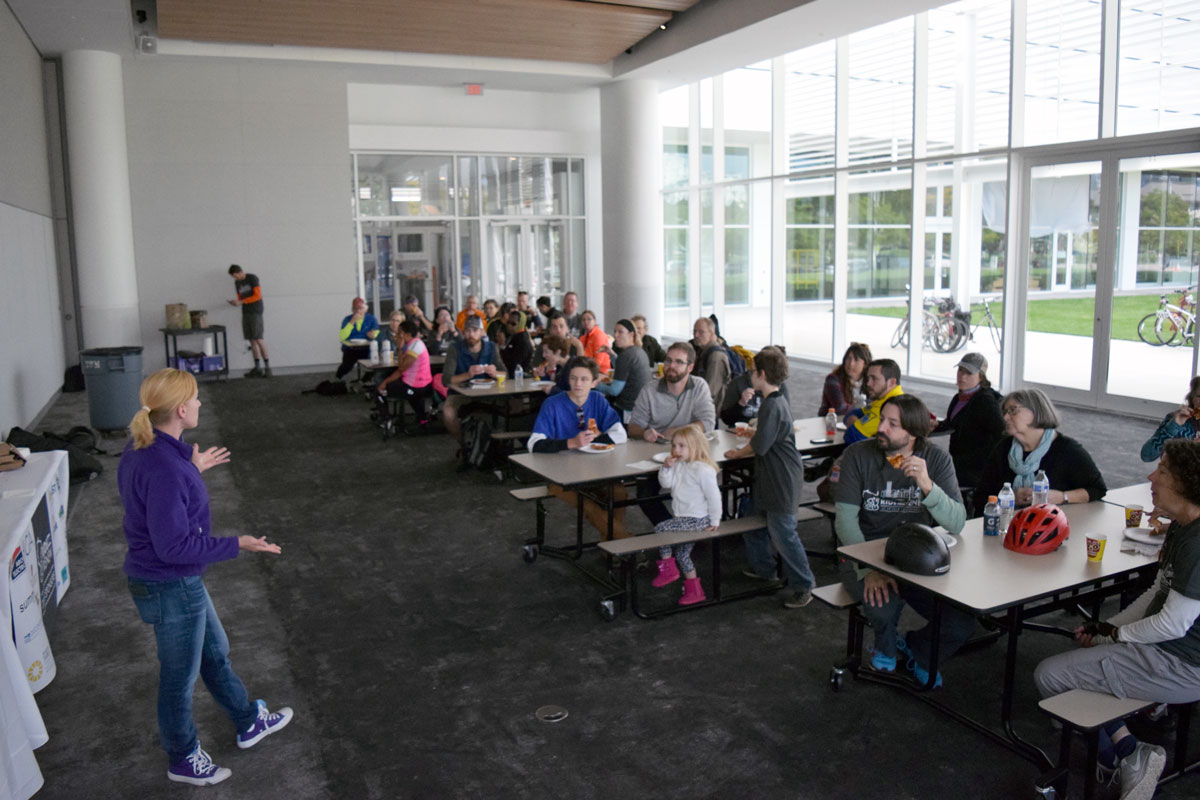 Have you ever had solar-powered pizza delivered by an electric car? We did! Our lunch was delicious and provided by Bounce Milwaukee. Bounce uses solar electricity to power solar ovens that cook pizzas, which are then delivered by electric cars. Ice cream was also provided by Cedar Crest Ice Cream.
Have you ever had solar-powered pizza delivered by an electric car? We did! Our lunch was delicious and provided by Bounce Milwaukee. Bounce uses solar electricity to power solar ovens that cook pizzas, which are then delivered by electric cars. Ice cream was also provided by Cedar Crest Ice Cream.
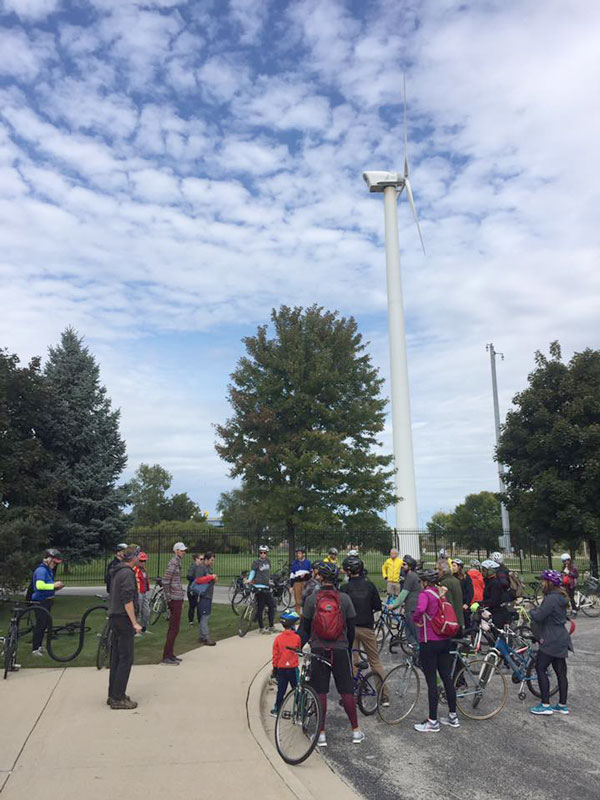 After lunch, we visited the Port of Milwaukee’s wind turbine which is close to producing 1 million kilowatt-hours of electricity and is coming up on six years of operation.
After lunch, we visited the Port of Milwaukee’s wind turbine which is close to producing 1 million kilowatt-hours of electricity and is coming up on six years of operation.
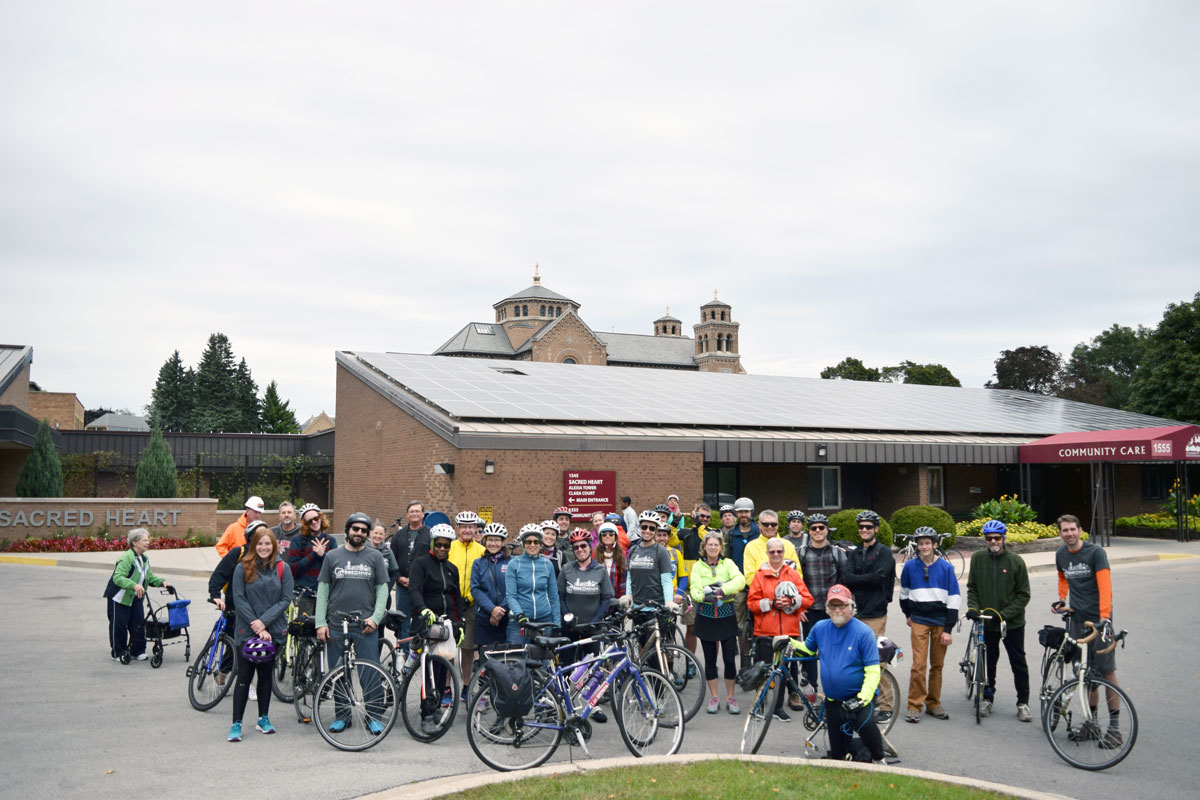 Then, two non-profit organizations showed how broadly solar has grown. Mike Cornell of Arch Electric showed off their project at the School Sisters of St. Francis, which we believe is the largest solar project for a religious order in Wisconsin. The solar panels at this project are made in Jackson, Mississippi, by Seraphim.
Then, two non-profit organizations showed how broadly solar has grown. Mike Cornell of Arch Electric showed off their project at the School Sisters of St. Francis, which we believe is the largest solar project for a religious order in Wisconsin. The solar panels at this project are made in Jackson, Mississippi, by Seraphim.
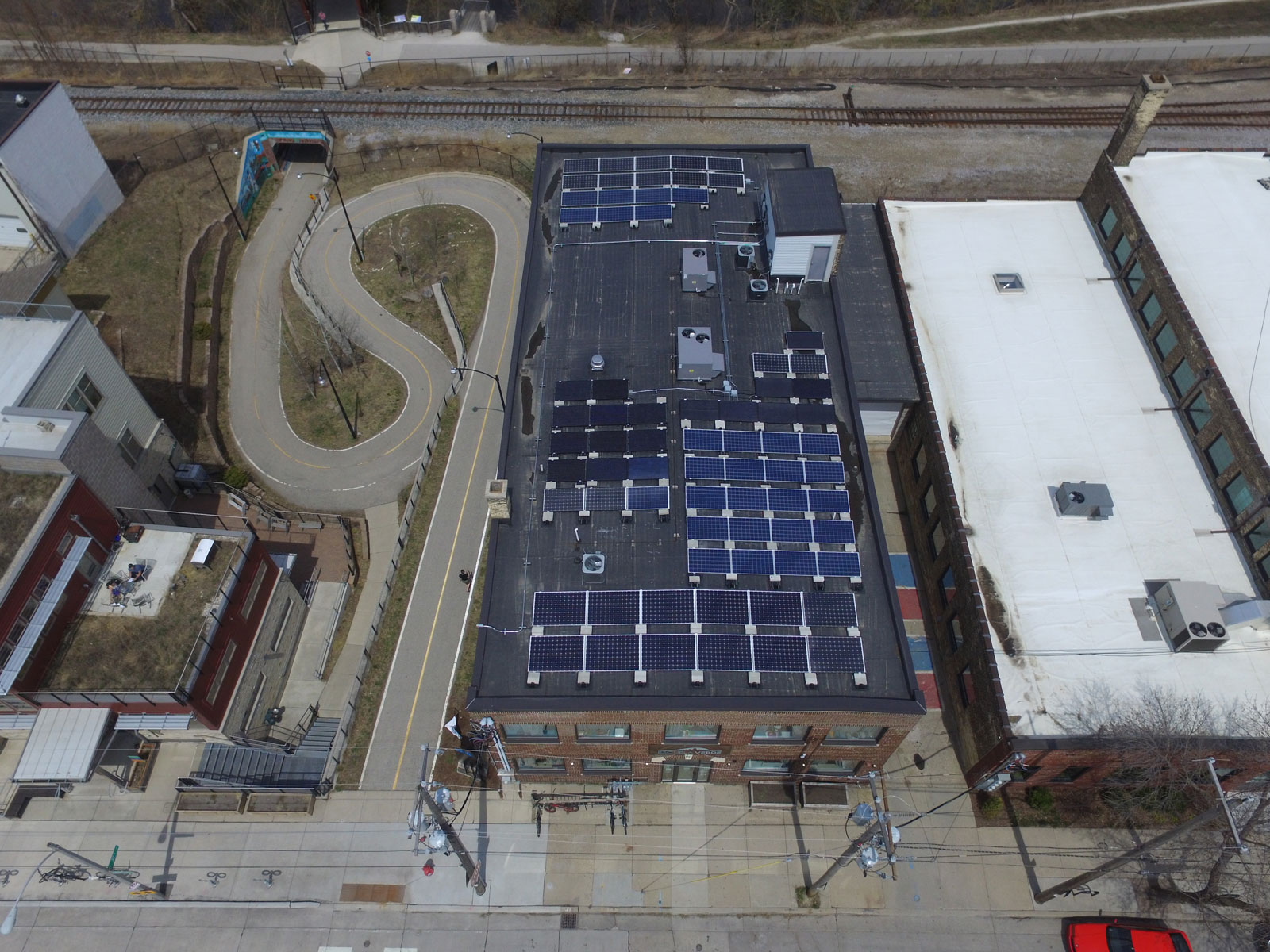 Escuela Verde was our second-to-last stop, where Catie Malcheski of Sunvest described the school’s vision and actions to get solar. The panels had been donated by Helios when it was making panels in Milwaukee a few years ago, but the school needed to raise the money to complete the installation. RENEW’s Solar for Good program was a key contributor to making the project happen!
Escuela Verde was our second-to-last stop, where Catie Malcheski of Sunvest described the school’s vision and actions to get solar. The panels had been donated by Helios when it was making panels in Milwaukee a few years ago, but the school needed to raise the money to complete the installation. RENEW’s Solar for Good program was a key contributor to making the project happen!
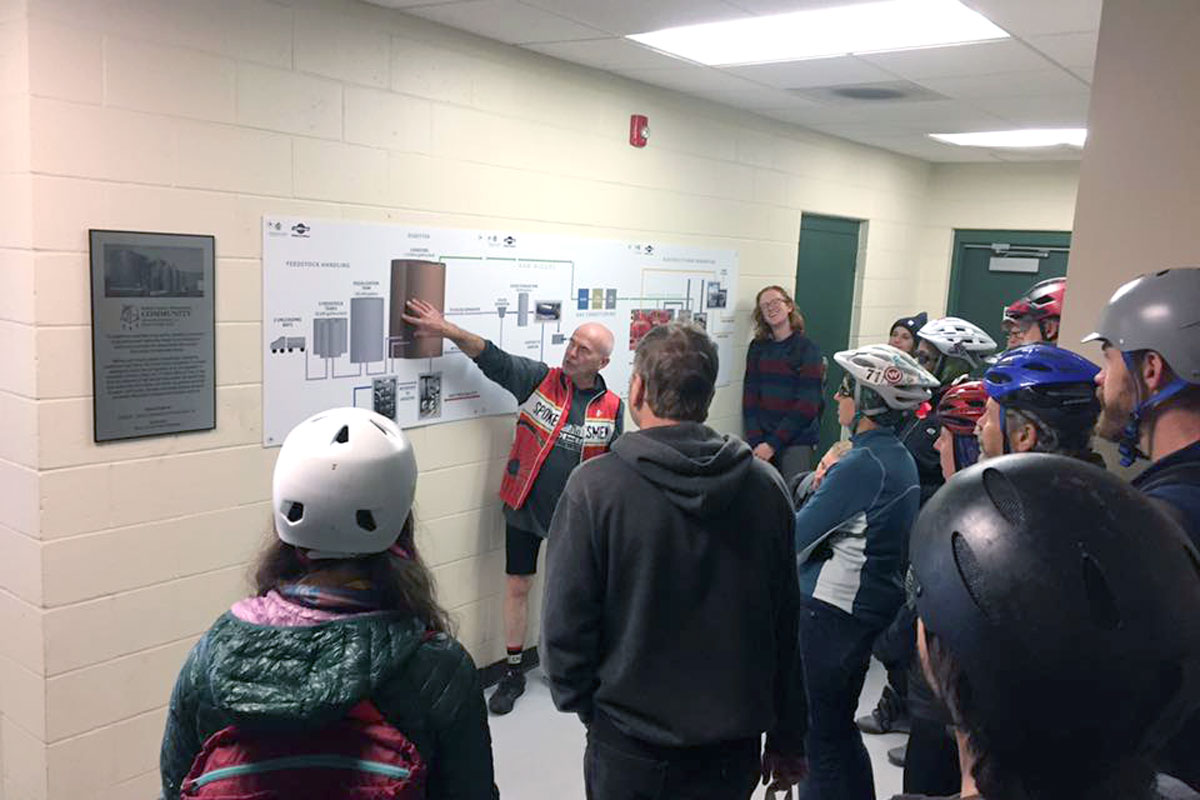 Our last stop was at the Forest County Potawatomi Community’s Biodigester, which is located next to the casino. The Biodigester takes food waste from the casino and other locations and turns it into biogas, which is then used to create electricity. Waste heat is also piped to the casino in the winter. Charlie Opferman of the Potawatomi Community told us how the biodigester is basically a big stomach in action.
Our last stop was at the Forest County Potawatomi Community’s Biodigester, which is located next to the casino. The Biodigester takes food waste from the casino and other locations and turns it into biogas, which is then used to create electricity. Waste heat is also piped to the casino in the winter. Charlie Opferman of the Potawatomi Community told us how the biodigester is basically a big stomach in action.
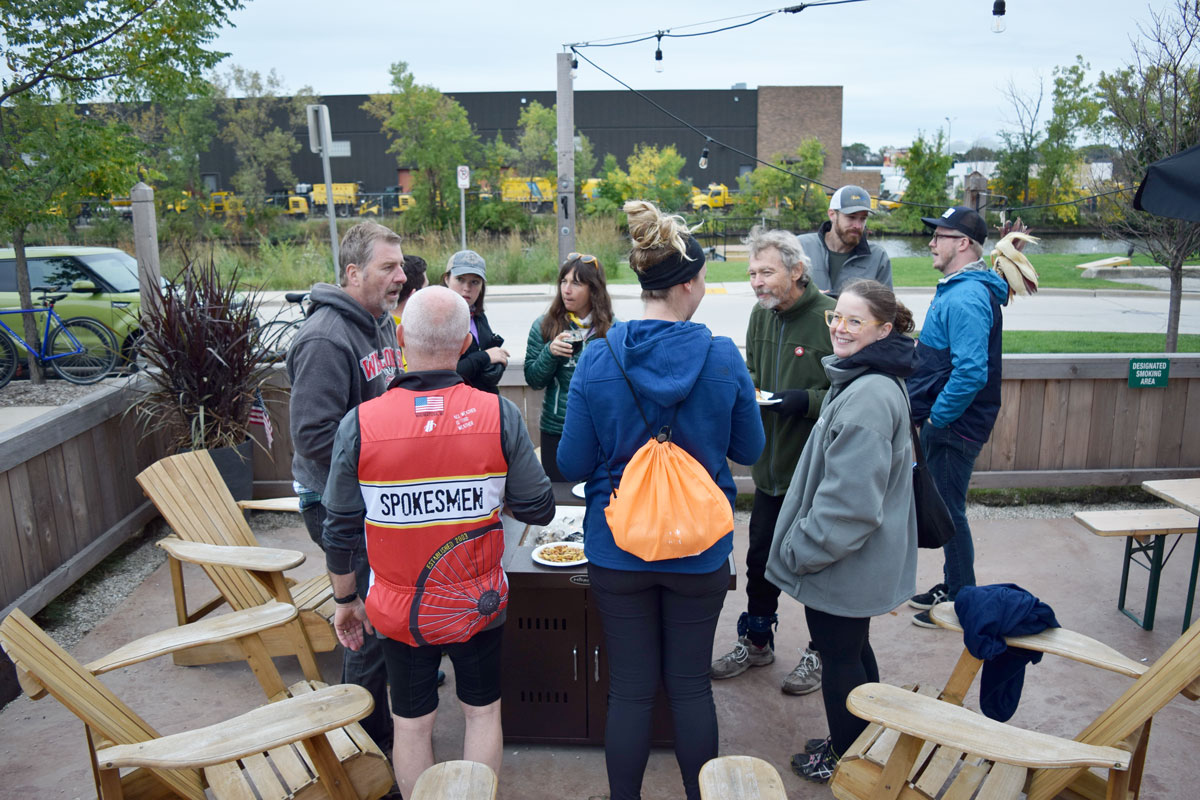 We finished up by having a beer and snacks at City Lights Brewing Company.
We finished up by having a beer and snacks at City Lights Brewing Company.
We also once again enjoyed excellent financial support from our sponsors, RENEW Wisconsin members, and friends and family of our bike riders who donated to support the riders. John & Mary Frantz offered to match up to $15,000 in donations towards our ride, and we exceeded our goal again! All event proceeds will support RENEW Wisconsin’s ongoing work to advance renewable energy in Wisconsin.
Thank you once again to all of our riders, sponsors, and supporters!
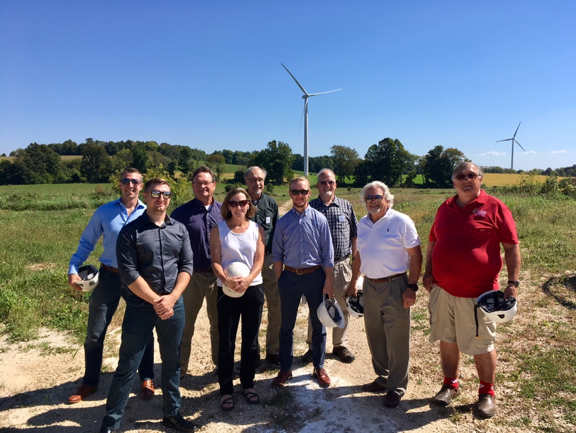
by Jim Boullion | Oct 2, 2018 | Advocacy, Biogas, Electric Vehicles, Events, Jobs, Policy, RENEW Wisconsin, Renewables, Solar, Utilities, Wind
September was a busy month for me and RENEW Wisconsin. I attended more than 30 meetings, seminars and site visits all over the state. Many of them involved learning about Wisconsin’s exciting and fast growing renewable energy industry and building relationships with the talented people who help make it go. There were also numerous meetings with state and local policy makers as well as the leadership of many influential trade associations, unions and advocacy groups. Working together, we are starting to develop ideas for the 2019-20 legislative session that will help advance the use of clean, renewable energy that will create jobs, economic growth and save money for everyone!
Customers First! Power Lunch – Go Electric!
September got off with a “high voltage” start at the Customers First! Coalition Power Lunch, with the theme of “Go Electric”. Over 120 attendees learned about the latest developments and benefits of electric vehicles and “efficient electrification” – replacing direct fossil fuel use with electricity in a way that reduces overall emissions and energy costs. Efficient Electrification holds significant potential benefits for Wisconsin customers, utilities, and environmental advocates alike. PSC Chairman Lon Roberts gave the opening keynote speech and several panels with utility executives and state legislators Mark Spreitzer (D-Beloit) and Mike Kuglitsch (R-New Berlin) dove deeper into the technical and policy issues that will need to be addressed to keep up with these fast-growing trends. The program was interesting enough that WisconsinEye, the not-for-profit State Capitol broadcast network, recorded the event.
Emmi Roth Solar Panels
On September 11th I joined State Representative Travis Tranel at the Emmi Roth Cheese plant in Platteville to cut the ribbon on their new 1,600 panel solar system. The system will provide 15% of their electric use. “There are many companies trying to live up to sustainability goals,” said Jim Pullen, General Manager at Eagle Point Solar, who installed the system. “Emmi Roth is part of a group that actually makes these goals a reality and invests in the environment.” The company also recently invested in a new anaerobic digester at the same location in Platteville, Wisconsin, in an effort to lower operational costs and remain environmentally responsible for the waste being produced during their cheesemaking operations. According to Tim Omer, president and managing director at Emmi Roth, “We have a very strong commitment to sustainability. We want to have the lowest possible carbon footprint we could have in the industry.”
Butler Ridge Wind Farm
On September 17th, Pauline Meyer and Nic Cravillion, policy staff from Congressman Mike Gallagher’s office, and Dodge County Board member Russ Kattke joined me at a tour of the Butler Ridge Wind Energy Center in Dodge County. This was a behind the scenes tour of one of Wisconsin’s premier wind farms and was hosted by NextEra Energy Resources. Butler Ridge’s 36 turbines generate 54-megawatts of clean, renewable energy to power more than 13,500 homes. Wisconsin based Faith Technologies, who installed the ground grid and in-tower wiring, and The Boldt Construction Company were two of the prime contractors on the project.
Conservative Energy Forum Summit on “Advancing Wisconsin’s Clean Energy Economy” and Clean Energy Week Proclamation by Governor Walker
On Thursday, September 27th the Wisconsin Conservative Energy Forum hosted a summit onclean energy developments in Wisconsin. PSC Commissioner Lon Roberts opened the meeting discussing the bright future of renewable energy. Several guest panels discussed Utility Scale Clean Energy – A Turning Point for Wisconsin Utilities, and Decentralizing Energy & Encouraging Private Sector Investment. Lt. Governor Rebecca Kleefisch also spoke about the great things happening for clean energy in Wisconsin and how renewable energy fits so well into a conservative political viewpoint. At the end of her talk, Kleefisch presented a proclamation from Governor Scott Walker designating September 24th to September 28th as Clean Energy Week in Wisconsin. This echoed the clean energy week activities around the country.
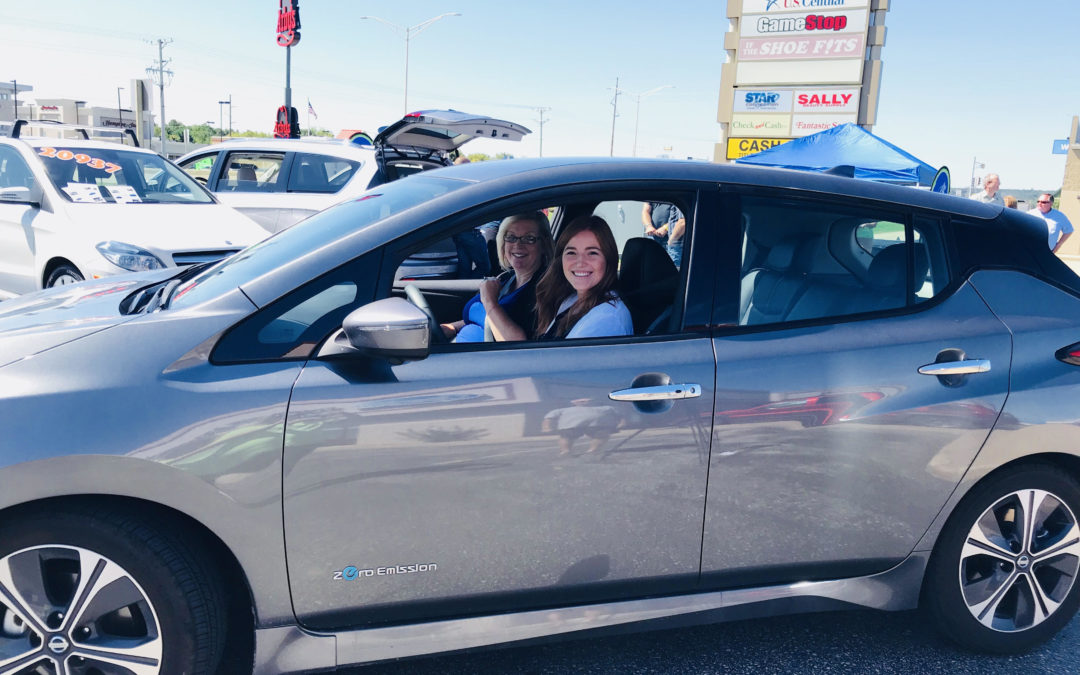
by Jane McCurry | Oct 1, 2018 | Electric Vehicles
Hello! My name is Jane McCurry and I started working as a Program Manager at RENEW Wisconsin in July of 2018. My work involves researching the electric vehicle (EV) market and trying to figure out what RENEW Wisconsin can do to accelerate EV adoption.
My Story
I grew up in Metro-Detroit and both of my parents worked for Ford Motor Company. My connection to the automotive industry is made nearer and dearer by my family’s ties to Henry Ford. Henry Ford’s mother, Mary Litogot Ford, is an aunt on my maternal direct lineage (my mom’s maiden name is Litogot). Growing up, I loved learning about Henry Ford and the rise of automobiles and it seems natural that my role with RENEW has started with studying the transportation sector.
I’ve spent my first two months deeply researching electric vehicles, charging stations, learning what other states and advocacy groups are doing, and investigating the Volkswagen diesel emissions settlement, which provides funding to every state to advance cleaner vehicles.
Before my job at RENEW, I had never driven an EV and didn’t know much about them. After getting behind the wheel of the Tesla Model 3, Chevy Bolt, Chevy Volt, Ford Fusion Energi, and the Nissan Leaf, I can say that all of them are quiet and much more fun to drive than my current car. I am fond of my red Ford Escape, but it will definitely be my last gasoline vehicle.

Electric Vehicles Match RENEW’s Mission
Not only are EVs fun to drive, but they represent a huge opportunity to decrease fossil fuel use and increase renewable energy production in Wisconsin. If cars run on electricity instead of petroleum, we can drive on energy produced in Wisconsin from renewables. That means no tailpipe emissions and cleaner air for everyone.
The market for electric vehicles is just starting to develop. If more consumers (like you and me!) are educated about the benefits of driving electric, there won’t be any doubt that EVs are the best option. I’m confident many of the short-term barriers to adoption will go away as demand for EVs increases. With proper consumer awareness, EV adoption has the potential to skyrocket.
I’m excited for a future where we all drive on renewable energy. Stay tuned for more information about transportation electrification, what RENEW is doing to support adoption, and opportunities to fuel our vehicles with clean, renewable energy.

by Heather Allen | Oct 1, 2018 | Solar, Solar for Good
More Solar Energy for Wisconsin Nonprofits
RENEW Wisconsin’s Solar for Good program today opened its third application process with approximately $100,000 in grants available for mission-driven nonprofit organizations across Wisconsin seeking to install solar power.
The grants assist nonprofits in funding the cost of a clean, renewable solar power project. Smaller grants can also provide technical assistance, including professional solar site assessments and engineering services, needed to get solar projects off the ground.
Solar power is very popular with mission-driven nonprofits because it aligns with their goals to improve people’s well-being and create a better future. The projects also help nonprofits save money on energy costs.
Through the first two rounds of this Solar for Good, successful solar projects have been supported for organizations of faith, those serving human needs, groups protecting special places, and more. The first two rounds occurred in Fall 2017 and Spring 2018, and so far, 25 solar projects have been awarded grants, and 12 projects are already completed.
“We are very pleased to announce our third round of Solar for Good funding to help more Wisconsin nonprofits take advantage of solar energy. Solar energy is healthy energy for people and for the beautiful Wisconsin landscapes we all enjoy,” said Tyler Huebner, Executive Director of RENEW Wisconsin.
Solar for Good is funded through generous donations from local philanthropists Cal and Laurie Couillard of Deerfield and additional donors. The program provides up to 20% of the cost of a solar array, with a grant cap of $10,000 for solar arrays sized less than 75 kilowatts and a grant cap of $20,000 for arrays 75 kilowatts and above. Solar for Good has already awarded over $200,000 in grants, resulting in nearly $1.8 million of new solar power projects in Wisconsin.
In return for funding assistance, recipients of the Solar for Good grants help spread the word about their project and educate their communities about solar power’s benefits.
How to Apply
Organizations can learn more and apply at https://www.renewwisconsin.org/solarforgood/.
In order to be eligible, the organization must be a registered nonprofit organization located in Wisconsin, be in good financial standing, be ready to install solar and agree to participate in educating community members about the benefits of solar energy. If approved for a grant, all fundraising, design and installation for the solar project must be completed within 12 months.
Applications are open now for this round of funding and must be received by Tuesday, November 13th 2018 at 5:00pm. Decisions and funding announcements will be made by Monday, November 26th, 2018.
For organizations looking at solar for the first time, technical assistance grants are available to fund a solar site assessment (up to $250) or engineering review (up to $500) for their solar array. These applications will be reviewed separately from the applications for grants for solar installation and will be awarded on a first-come, first-served basis.
About RENEW Wisconsin
RENEW Wisconsin is a nonprofit organization which promotes renewable energy in Wisconsin. We work on policies and programs that support solar power, wind power, biogas, local hydropower, and geothermal energy. More information is available on RENEW’s website: www.renewwisconsin.org.
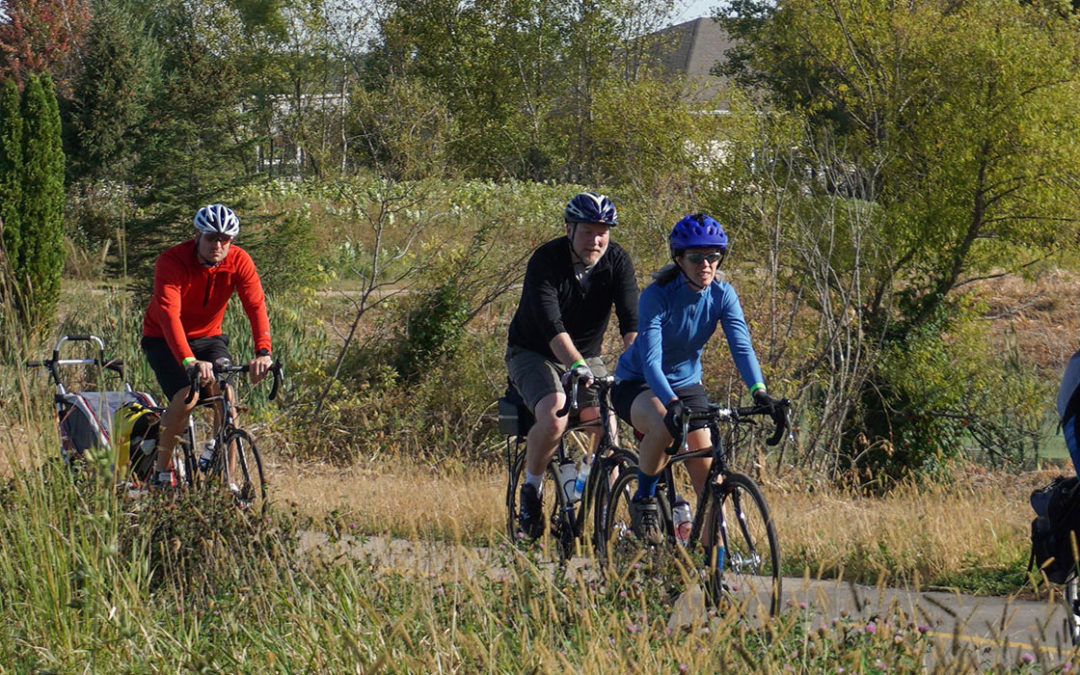
by Jodi Jean Amble | Sep 17, 2018 | Biogas, Events, Geothermal, RENEW Wisconsin, Renewables, Solar, Wind
September 29 event to highlight area renewable energy projects.
Madison, WI – On Saturday, September 29th, RENEW Wisconsin will host its 6th annual “Ride with RENEW” bicycle tour of renewable energy projects, with this year’s ride taking place in Milwaukee, WI. All event proceeds support RENEW Wisconsin’s ongoing work to advance renewable energy in Wisconsin.
Riders will travel approximately 25 miles on paved roads and bike paths to visit innovative wind, solar, geothermal, and biogas energy generation facilities in Milwaukee.
The total tour time will be approximately 6 hours (including stops at renewable energy sites) and actual riding time will be 2 to 3 hours.
Participants will get an inside look at some of the area’s leading renewable energy projects and will enjoy breakfast, lunch, and beverages along the way. They will visit with installers and workers who are advancing renewable energy every day, and hear from customers about why clean energy works for their pocketbooks and their businesses.
The day’s tour will include:
- Gather at Ingeteam parking Lot a 9:00 a.m. departure. – Ingeteam has a LEED Gold, 138,000 square foot industrial facility and is a leading manufacturer of wind and solar energy products.
- Milwaukee Public Museum – MPM features 234 solar panels on its south-facing tower wall. The panels are linked to a kiosk located on the ground floor that provides near-real-time data on the energy generated by the panels.
- Discovery World Science and Technology Center – Discovery World at Pier Wisconsin is a youth-oriented science and technology museum and aquarium in downtown Milwaukee and features geothermal heating and cooling.
- Port of Milwaukee Wind Turbine – The City of Milwaukee’s Environmental Collaboration Office (ECO) and the Port of Milwaukee partnered to install a 100 kilowatt wind turbine at the Port. Installed by Kettle View Renewable Energy, the turbine provides more than 100 percent of the electricity needed by the Port administration building.
- Escuela Verde – This public charter school, designed to support students interested in sustainability, student-led learning, and restorative justice, was a recipient of a 2017 Solar for Good grant. In 2018, 60 solar panels were installed by SunVest and Current Electric on the roof of the school.
- School Sisters of Saint Francis – The Milwaukee branch of the School Sisters of Saint Francis partnered with Arch Electric to install 1,086 solar panels on the rooftop of the St. Francis Sacred Heart building in 2017. Producing 375 kilowatts of solar, the solar array is able to help offset more than 12 percent of the electricity consumed at the Sacred Heart facility.
- Potawatomi Biodigester – This waste-to-energy project converts waste materials generated by the food and beverage industries to electricity. The electricity produced is sold to WE Energies as renewable energy.
- The ride will conclude at City Lights Brewery for refreshments at around 4:00 p.m.
Registration for the ride is open through September 28th. The cost is $40 for members of RENEW Wisconsin, $50 for non-members, and $70 to both register for the ride and become a member of the organization for one year. All donations to RENEW Wisconsin for this charity bike ride are matched up to $15,000 by generous donors John & Mary Frantz of Madison!
Individuals and businesses can donate to RENEW Wisconsin or in support of a rider, sign on as an event sponsor, or volunteer on ride day.
“We are very excited to tour some of Milwaukee’s best renewable energy projects on Saturday, September 29th,” said Tyler Huebner, Executive Director of RENEW Wisconsin. “This tour allows us to showcase a variety of ways to produce homegrown, clean energy right here in Wisconsin including wind, solar, and even food waste. This is a really fun event where you can meet great people, help a good cause, and learn together about clean energy in Wisconsin.”
Sponsors of the Event include Arch Electric, HGA, SunVest, Bounce Milwaukee, Discovery World, Milwaukee County, Summit Credit Union, SunPeak, UW Engineering Professional Development, Current Electric, H&H, Milwaukee Shines, Wegner CPAs, and Open Circle Unitarian Church – Fond du Lac.
There is still time to sponsor if your business or organization wishes to do so.
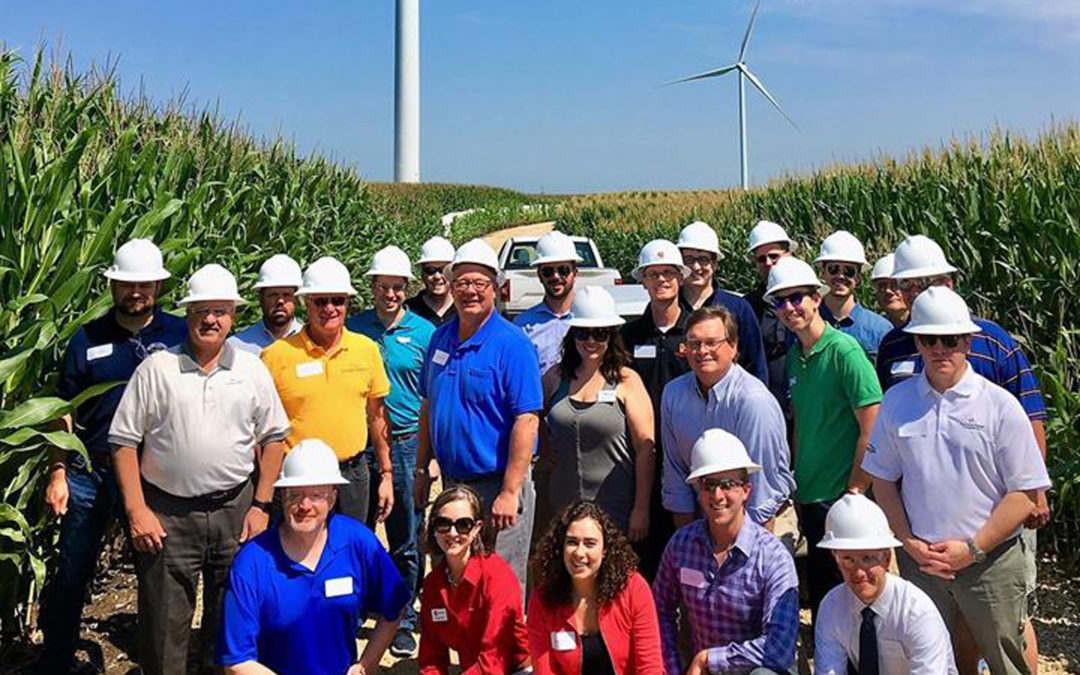
by Jim Boullion | Sep 4, 2018 | Biogas, Events, RENEW Wisconsin, Renewables, Solar, Utilities, Wind
Quilt Block Wind Farm
On August 9th, Vanessa Tutos, Director of Government Affairs for EDP Renewables hosted me and a large group of legislators, legislative staff and other interested people on a tour of their Quilt Block Wind Farm near Darlington, Wisconsin.
During a pre-tour briefing, Vanessa and the EDP Renewable staff gave an overview of the facility and how it works. Darlington Mayor Dave Breunig also participated in the briefing, explaining the many benefits that the Quilt Block facility brings to the local communities, including not only the town and county tax revenues, but the good paying jobs at Quilt Block and the many community businesses that benefit such as restaurants, hotels and other shops.
In attendance were State Senator Howard Marklein and Rep. Todd Novak. Legislative staff: Garrett Huffman, Rep. Kuglitsch (Assembly Utilities Committee Chair); Kyle Koenen and JJ Sherman, Sen. Kapenga staff; Brian Radday, Sen. LeMahieu staff (Senate Utilities Committee Chair); Evan Miller, Sen. Cowles staff (Senate Energy Committee Chair); Dave Breunig, Mayor of Darlington; Alex Ignatowski, Wis. Public Service Commission; Ryan Owens, Tommy Thompson Center on Public Leadership – UW Madison; Jon Hochkammer, Wisconsin Counties Association; Rob Richard, Wisconsin Farm Bureau; Tim Hoven, EDPR
School Sisters of St. Francis
On Tuesday, August 22nd, the Wisconsin Association of Energy Engineers invited me and Jane McCurry of the RENEW Wisconsin staff to tour something old and something new, all in one location, the School Sisters of St. Francis campus in Milwaukee. The Sisters recently installed a 375-kW solar array with 1,086 panels on several of their buildings.
Sister Carol Rigali, Coordinator of the province leadership team, specifically asked that the panels be made in the USA. As Mike Cornell of Arch Electric explained, they acquired the panels from Seraphim Solar USA, from Jackson, Mississippi. Sister Carol said that St. Francis expects to save $1.5 million in energy costs over the life of the system, but that was only one reason they did the project.
She noted that in his 2015 encyclical Laudato Si, Pope Francis specifically mentioned installing solar panels as one way to care for creation. “This solar energy project will enable us to lessen our energy consumption and to invest in our care of the earth.” The chapel was finished in 1914 but looks as amazing as the day it was built. The art and architecture inside compare to some of the best churches anywhere in the world. Now they have a state-of-the-art solar generation system that will help them achieve their mission now and into the future. Preserving the past by embracing the future! Nicely done Sisters!
Wisconsin Agriculture Coalition
On Monday, August 27, I was joined by RENEW Wisconsin’s Executive Director Tyler Huebner, Scott Smith from Madison Gas & Electric and Neil Palmer from Invenergy to give a briefing to the Wisconsin Agriculture Coalition about the latest developments in renewable energy and how it may affect their members. The Agriculture Coalition is a group of association executives and government affairs staff who meet regularly to discuss legislative and regulatory issues in which they have a common interest.
I opened the meeting by discussing the changing economics and politics of renewable energy and let them know that they are going to be seeing a lot of activity in Wisconsin. Tyler then gave an overview of renewables in Wisconsin that will especially impact farms and agriculture related businesses such as solar and wind farms and biogas generation. Scott gave the utility perspective on why they are all adding large scale renewables to their portfolio and the benefits that they see for their customers. In particular, he noted that the driving force was the impressive price drop of over 75% for solar power in the last 10 years.
Finally, Neil spent some time explaining how Invenergy goes about developing a utility scale solar project, from identifying good locations with access to substations and landowners with enough flat, open land who are interested in leasing their property, to the steps and timing of the regulatory process. We also had a good discussion about the “frequently asked questions” that they may be hearing from their members and how to answer them. In summary, everyone in attendance received a good, general understanding of the amazing changes that are happening in the renewable industry and that RENEW Wisconsin is their source for reliable, fact-based information!
Members of the Ag Coalition include:
- Wisconsin Farm Bureau Federation
- Wisconsin Farmers Union
- Dairy Business Association
- Wisconsin Cheese Makers Association
- Midwest Food Products Association
- Wisconsin Agri-Business Association
- Wisconsin Association of Professional Agricultural Consultants
- Wisconsin Cattlemen Association
- Wisconsin Pork Association
- Wisconsin Soybean Association
- Wisconsin Potato and Vegetable Growers Association
- Wisconsin Corn Growers Association
- The Cooperative Network Associations
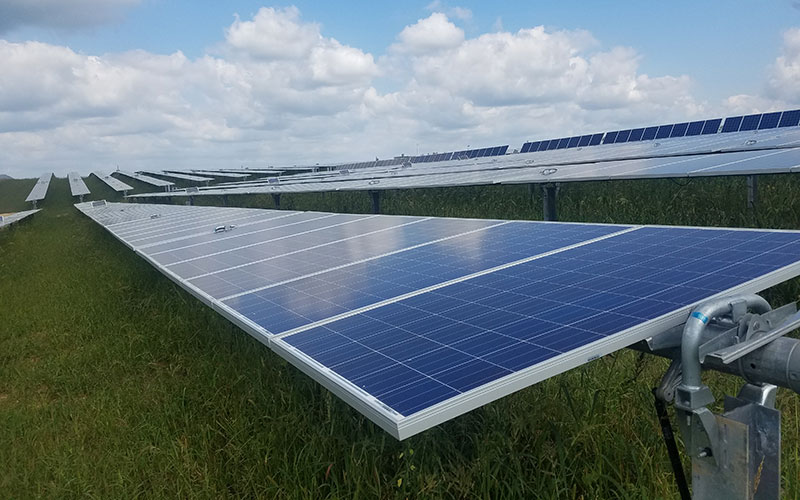
by Michael Vickerman | Aug 22, 2018 | Local Initiatives, RECs, Renewables, Solar
A recently signed contract between the City of Madison and OneEnergy Renewables, LLC, a solar developer headquartered in Seattle, will result in the construction of five community solar arrays totaling 14 megawatts (MW) next year in western Wisconsin. The City’s decision to provide financing to this project represents the largest commitment to date by a single Wisconsin customer to expanding solar capacity here.
Expected to begin operating in mid-2020, OneEnergy’s five arrays should produce about 20 million kilowatt-hours of clean electricity a year over its operating life. That output equates to more than one third of the City of Madison’s own consumption.
OneEnergy’s solar arrays will be built in the service territories of the municipal utilities serving Argyle, Cumberland, Elroy, Fennimore, and New Lisbon. These five utilities will receive the electricity at a price comparable to what they currently pay for wholesale power. However, under the city’s contract with OneEnergy, Madison will receive 25 years of renewable energy credits, or RECs, associated with the project’s output.
The $1.4 million contract will move Madison substantially closer to its goal of sourcing 100% of the electricity used for city operations from renewable energy sources. Madison is one of three Wisconsin municipalities that adopted a 100% renewable energy goal. The others are Eau Claire and Middleton.
Approved by Madison’s Common Council in July, the city’s REC purchase is an essential element in the overall financing for OneEnergy’s solar project. Though the power from the arrays will flow to five different municipal utilities, the agreed-upon purchase price will not, by itself, pay for the project’s full cost. But with the additional revenue stream coming from the City’s REC purchase, the developer should have no difficulty in securing outside investors to participate in the project.
“Through this creative arrangement, new community solar projects totaling 14 MW will move from the drawing boards out into the western Wisconsin landscape,” said RENEW policy director Michael Vickerman. “At a remarkably low cost, the City will expand solar generating capacity in Wisconsin by 15%, and these new sources of zero-carbon power will provide tangible benefits to the City, the rural communities hosting these arrays, and our planet.”
Madison’s action is the second major REC purchase by a Wisconsin customer to support the construction of community-scale solar projects. Last November, LaFarge-based Organic Valley Cooperative, the nation’s largest cooperative of organic farmers, entered into a similar arrangement with OneEnergy to purchase RECs from 12 MW of solar capacity serving another group of small municipal electric utilities. Through that transaction Organic Valley expects to reach its goal of being 100% renewably powered by 2020.
Constructing both sets of arrays will involve only one mobilization of construction equipment and crews. According to OneEnergy, combining the Organic Valley and City of Madison projects into one coordinated build-out will reduce construction costs, which helped make project participation more affordable for both the utility off-takers and the REC purchasers.
OneEnergy is also developing a 4 MW project next to Middleton’s airport with the aim of supplying the City of Middleton and a Madison-area business with solar electricity.
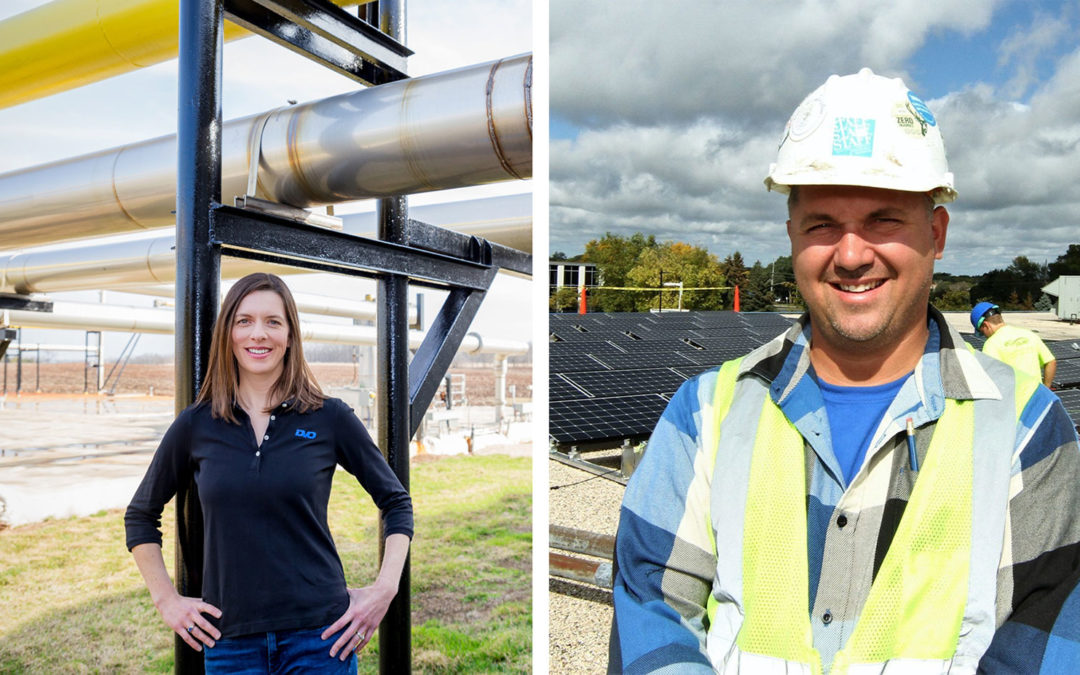
by Jodi Jean Amble | Aug 8, 2018 | Biogas, Jobs, Renewables, Solar, Sustainability, Wind
More than 75,000 Wisconsin residents now work in clean energy industries, including individuals in all 72 counties, according to a new analysis of energy jobs data from Clean Energy Trust (CET) and the national, nonpartisan business group E2 (Environmental Entrepreneurs). Wisconsin’s clean energy workforce employs more than all the waiters and waitresses, computer programmers, lawyers and web developers in Wisconsin combined, according to Department of Labor Employment Statistics.
Energy efficiency once again led all clean energy sectors in Wisconsin, employing 62,299 workers – accounting for 8 in ten of all clean energy workers.
Renewable energy generation came in second with over 5,600 jobs – led by solar and wind (5,351).
“Wind, solar, and energy efficiency are the lowest-cost options for utility companies and our state’s homes, businesses, and public-serving organizations. Wisconsin has a tremendous job creation opportunity because these clean energy technologies are now cost-effective and ready for prime-time,” said Tyler Huebner, Executive Director of RENEW Wisconsin.
Across the entire 12-state region, Clean Jobs Midwest found that clean energy employment totaled 714,255 at the end of last year.
Key findings about Wisconsin’s clean energy workforce include:
• Renewable energy, led by wind and solar, employs 5,660 Wisconsin residents
• Over 2,500 Wisconsin residents now work in grid modernization and energy storage
• The majority of Wisconsin’s clean energy jobs are in construction and manufacturing (75.30%)
• Clean fuels and clean vehicle technologies employ 4,565 workers
• Employers project 2.0% clean energy job growth in 2018
• Small businesses are driving Wisconsin’s clean energy sectors, with 67.90% of clean energy businesses employing fewer than 20 individuals.
• 11% of Wisconsin residents employed in clean energy are veterans
















